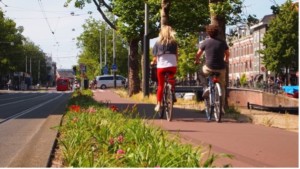A Mobyconer in China Part 2: What Safe Active Transportation Facilities Have in Common
This is the second part of my travel blog to continue highlighting my visit to China in the Fall of 2021. If you missed the first part about their bike-sharing programs, here is the link.
When I stumbled across streets and intersections in Chinese cities, the good designs always drew my attention for their safety benefits (both perceived and physical). These designs resonated with me because they share many similarities with the Dutch best practices. More importantly, the designs are great applications of and speak to the Sustainable Safety [1] principles, the Dutch equivalent of Vision Zero and the Safe System approach. Here are my main findings and observations.
(Bio)mechanics
The design principle of (bio)mechanics implies limiting differences in speed, direction, mass and size, and giving road users appropriate protection. Applying this principle to the design of cycling facilities on high speed and high-volume roadways, means creating a separate domain for slow-moving traffic which would reduce the major speed differences for mixing bicycles in fast-flowing traffic. It also translates to a dedicated domain which eliminates vehicles in larger mass entirely. Spot the design familiarities in China and the Netherlands and how they strive to achieve the (bio)mechanics principle.
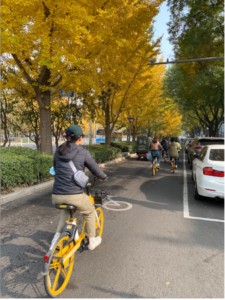 |
 |
Bike-friendly service road in Beijing, China vs Rotterdam, NL. The tree-lined median separates people cycling from fast traffic moving along the major thoroughfare. Although cars occasionally merge into the service road to seek parking, the Safety in Numbers [2] is experienced by the active mode users.
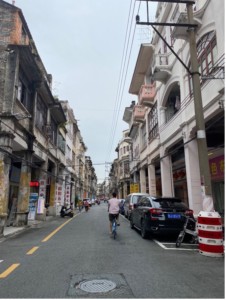 |
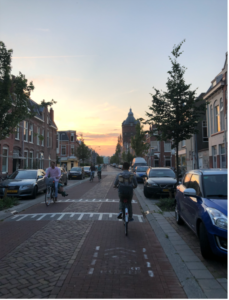 |
Low-traffic street (i.e., bicycle boulevard) parallel to the high-speed corridor in Canton, China vs Groningen, NL. The two-way street is narrow and requires drivers to make eye contact and show courtesy to pass each other, and as such traffic volumes and speeds are kept low.
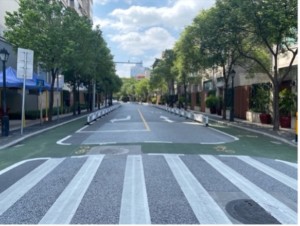 |
|
Physically separated bike lane in Canton, China vs Raised cycle path in Amsterdam, NL. One uses green paint and continuous barriers; the other uses red asphalt and green verge.
Psychologics
The design principle of psychologics calls for aligning the design of the road traffic environment with road user competencies, particularly for senior road users. This means that for both non-motorized road users and drivers, the information from the traffic system is perceivable, self-explaining, credible, relevant, and feasible. The great designs in China are identical to the Netherlands in principle, which meet the psychological needs of their local users.
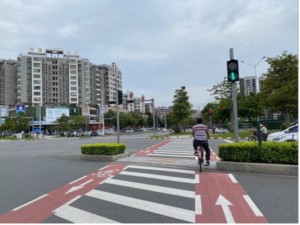 |
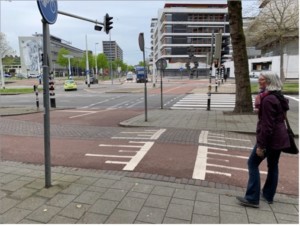 |
Staged pedestrian/ bike crossing and central refuge island in Canton, China vs Rotterdam, NL, to account for long crossing distance at major intersections. The uniformity of the design helps make traffic environment predictable to road users.
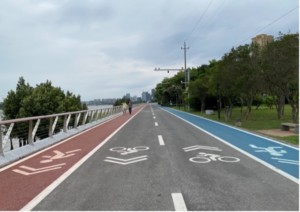 |
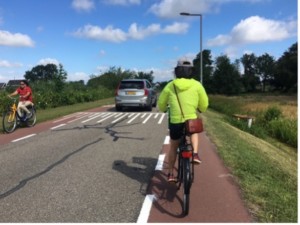 |
Colour schemes and pavement markings on a recreational trail to separate active users based on their abilities in Canton, China vs advisory bike lane in the countryside of Rotterdam, NL. It is no coincidence that higher speed traffic is facilitated toward the centre and lower speed traffic has the right-of-way with contrasting colour on the sides.
Effectively Allocating Responsibility
The Effectively Allocating Responsibility principle suggests a system approach where the government carries the ultimate responsibility to protect its citizens. The government must provide its citizens with the opportunity for mobility freedom and safety, including setting targets, enacting policies, developing design guidelines and monitoring and adjusting the goals and conditions accordingly. Traffic professionals carry operational responsibility to realize components of a sustainably safe traffic system. The private sector, including vehicle manufacturers, strives to develop products that offer road users maximum physical protection for themselves and those around them, and support them in making safe behavioural choices. Road users follow the rules and set a good example of children and teenagers.
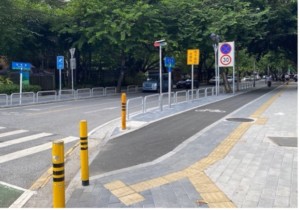
A compact, complete street in Canton, China, with a reduced posted speed limit, traffic surveillance, cycle track, tactile pavers for visually impaired people among others design features, to evoke the required travel behaviours. People driving drunk in China are subject to up to three years’ imprisonment, five-year license suspension. If the driver causes serious injuries or death, they will be charged with crime and their license will be permanently cancelled.
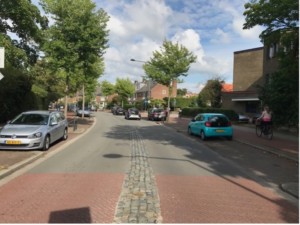
A typical complete street in Delft, NL that carries over 10,000 vehicles a day. The cobblestone median that makes driving surface visibly narrow, parking bays, separate cycle paths and sidewalks, raised intersections, together contribute to a self-enforcing 40 km/h speed limit and a forgiving traffic system. The possibilities of deaths and serious injuries are minimized from road user errors and weaknesses. In the Netherlands, injuring someone while drunk behind the wheel of a car carries a prison sentence of up to three years. Drivers who cause death by driving under the influence of alcohol may be charged with up to six years in jail.
Conclusion
Sustainable Safety includes more guiding principles than my examples outlined above. These principles also evolve through time. After-all, the approach is to proactively adapt to human factors and integrate the various elements of the road traffic and transport system optimally. It is universal and a Safe System approach.

Stay tuned for further updates about my travels and experiences in China.
Reference:
[1] Sustainable Safety – https://sustainablesafety.nl/
[2] Safety in Numbers – https://en.wikipedia.org/wiki/Safety_in_numbers


